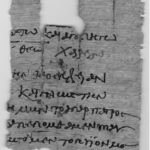| Artefact ID | 165 |
| TM ID | TM 129875 |
| Findspot (DEChriM ID) | 58 (Dayr al-ʿIẓām) | Class | Textual |
| Material | Papyrus |
| Writing medium | Sheet/roll |
| Text content | Documentary |
| Language | Greek |
| Archive/Dossier | Archive |
| Description | Gonis 2008: 81-83, no. 4; P.Misc. inv. II 11a: Letter to Apa Ioannes (?) Fragment of a letter, of which the names of the sender and the recipient are lost. Writing along the fibers, the back is blank. Nomen sacrum (but not standard: supralinear stroke over θεῷ). The editor states that: "it is likely that this is another letter addressed to Apa Ioannes. A Christian letter of this date that belongs to this particular collection is a strong candidate for inclusion in the archive; if we add the abstract noun used for the addressee (l. 3: theosebeian), typical of clergymen, and what little we can glean of the subject matter, which relates to some misfortune of the sender, the candidacy gains in strength". The Apa John of this archive was identified with the famous John of Lykopolis known by literary sources by Zuckerman 1995. Most of the Greek and Coptic letters of this archive are addressed by monks, clerics, soldiers, state officials and individuals to Apa John, so that he would intercede in their favour in dealings with the authorities or pray for them. |
| Selection criteria | Christian terms/formulas/concepts |
| Date from | 375 |
| Date to | 399 |
| Dating criteria | Palaeography and archive connection (Gonis 2008: 69-72). |
| Absolute/relative date | Relative date |
| Archaeological context | According to Constantine Zuckerman's reconstruction, the Apa John’s letters were presumably found in September 1897, during the excavations of Farag Ismael and Yassa Tadros on the mountain of Siout (Lykopolis), in the ruins of Dayr al-'Azam, the site of the monastery of John of Lycopolis. Yet they never reached the museum in Gizeh – like the other objects unearthed during these excavations – and must have ended on the market, where they were bought soon after the excavations (Zuckerman 1995: 191-192; Van Minnen 1994: 80-82, Gonis 2008: 69-72). Although not proven, this attractive hypothesis is generally accepted by scholars (see discussion in Van der Vliet 2015: 166-167, and some reservations in Choat 2017: 37-40). |
| Accession number | Oxford, Sackler Library, Papyrology Rooms EES P. Misc. inv. II 11 a |


 Json data
Json data




